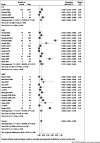Acute Facility Management of Blast Injuries In Low- and Middle-Income Countries: A Systematic Review and Meta-Analysis
- PMID: 40583404
- PMCID: PMC12237702
- DOI: 10.1017/S1049023X25101222
Acute Facility Management of Blast Injuries In Low- and Middle-Income Countries: A Systematic Review and Meta-Analysis
Abstract
Introduction: Blast injuries can occur by a multitude of mechanisms, including improvised explosive devices (IEDs), military munitions, and accidental detonation of chemical or petroleum stores. These injuries disproportionately affect people in low- and middle-income countries (LMICs), where there are often fewer resources to manage complex injuries and mass-casualty events.
Study objective: The aim of this systematic review is to describe the literature on the acute facility-based management of blast injuries in LMICs to aid hospitals and organizations preparing to respond to conflict- and non-conflict-related blast events.
Methods: A search of Ovid MEDLINE, Scopus, Global Index Medicus, Web of Science, CINAHL, and Cochrane databases was used to identify relevant citations from January 1998 through July 2024. This systematic review was conducted in adherence with PRISMA guidelines. Data were extracted and analyzed descriptively. A meta-analysis calculated the pooled proportions of mortality, hospital admission, intensive care unit (ICU) admission, intubation and mechanical ventilation, and emergency surgery.
Results: Reviewers screened 3,731 titles and abstracts and 173 full texts. Seventy-five articles from 22 countries were included for analysis. Only 14.7% of included articles came from low-income countries (LICs). Sixty percent of studies were conducted in tertiary care hospitals. The mean proportion of patients who were admitted was 52.1% (95% CI, 0.376 to 0.664). Among all in-patients, 20.0% (95% CI, 0.124 to 0.288) were admitted to an ICU. Overall, 38.0% (95% CI, 0.256 to 0.513) of in-patients underwent emergency surgery and 13.8% (95% CI, 0.023 to 0.315) were intubated. Pooled in-patient mortality was 9.5% (95% CI, 0.046 to 0.156) and total hospital mortality (including emergency department [ED] mortality) was 7.4% (95% CI, 0.034 to 0.124). There were no significant differences in mortality when stratified by country income level or hospital setting.
Conclusion: Findings from this systematic review can be used to guide preparedness and resource allocation for acute care facilities. Pooled proportions for mortality and other outcomes described in the meta-analysis offer a metric by which future researchers can assess the impact of blast events. Under-representation of LICs and non-tertiary care medical facilities and significant heterogeneity in data reporting among published studies limited the analysis.
Keywords: blast injuries; developing countries; disaster medicine; emergency medicine; international health.
Conflict of interest statement
The authors declare no competing interests.
Figures







References
-
- Action on Armed Violence (AOAV). 122% rise in global civilian fatalities from explosive weapons in 2023: a year of harm reviewed. AOAV. https://aoav.org.uk/2024/2023-a-year-of-explosive-violence-harm-reviewed/. Published January 8, 2024. Accessed July 30, 2024.
-
- Corral P, Irwin A, Mahler DG, Vishwanath T. Fragility and Conflict: On the Front Lines of the Fight against Poverty. Washington, DC USA: World Bank; 2020.
-
- Al-Hajj S, Farran SH, Zgheib H, et al. The Beirut ammonium nitrate blast: a multicenter study to assess injury characteristics and outcomes. J Trauma Acute Care Surg. 2023;94(2):328–335. - PubMed
-
- Arnold JL, Tsai MC, Halpern P, Smithline H, Stok E, Mass-casualty Ersoy G., terrorist bombings: epidemiological outcomes, resource utilization, and time course of emergency needs (Part I). Prehosp Disaster Med. 2003;18(3):220–234. - PubMed
Publication types
MeSH terms
Grants and funding
LinkOut - more resources
Full Text Sources
Research Materials

